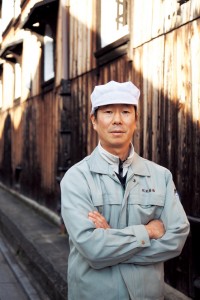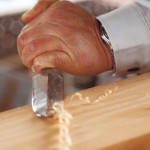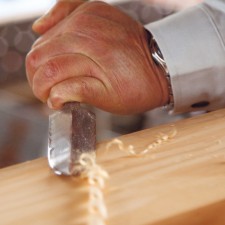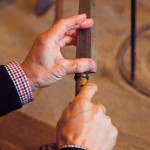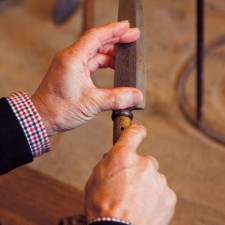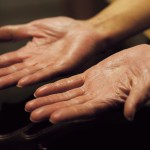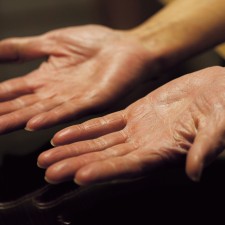Machines have no intuition
The sake production process
The manufacturing process of sake is rather different from that of other fermented brews, like wine or beer. All of them are produced through the two major stages of saccharification and alcoholic fermentation, but in the case of wine, the sugars are already present in the grapes from the beginning, and you just need to crush the grapes and add yeast, or if there are yeast spores on the grape skins, the liquid will ferment by itself. Since the alcohol content is low, this only takes about a week or ten days. Then you simply have to wait for the wine to mature. For beer, malt is already like koji. You begin by converting the malt into a sweet wort, and then add yeast. In the case of sake, however, it is very difficult to turn rice starch into sugars in the first place. You have to make koji. During the fermentation, there is both yeast and not yet saccharified starch in the tank at the same time. As the saccharification proceeds, the number of yeast cells also increase gradually, and you have to keep tight control of the balance between saccharification and alcoholic fermentation, that is to say the action of the microorganisms.
The whole sake-manufacturing procedure starts with milling rice. For standard sake, 30% of the brown rice is polished away to bran and is not used. For dai-ginjo, it is more than half, and then a further 40% of the remainder becomes sake lees, and not sake. It is a rather extravagant way of using rice. When the rice is polished, moisture evaporates due to frictional heat, and that has to be replenished through humidification. It usually takes about two or three weeks for the rice to diffuse all the frictional heat and settle down.
The work at our brewery starts from that point. The rice is washed, soaked and steamed, and then the process of making koji begins. Soaking rice in water may sound simple but there is no such thing as a perfect soaking. There will always be some unevenness. Even with the same variety of rice, the condition of the raw materials changes every year. You need to adjust the soaking time to the specific characteristics of that year’s rice. You also need to consider what kind of koji you want to make. Machines don’t understand those characteristics. You can’t capture them completely with component analysis either. In years when the summer is hot, the quality of the starches changes so that the rice is harder to dissolve. You have to keep this in mind and prolong the soaking time. You also have to increase the amount of seed koji slightly and make sure to bring in all the steamed rice into the koji muro before it gets hard. This is all controlled by hand.
To make koji, the steamed rice is cooled to about 30 degrees and then sprinkled with seed spores of koji mold (Aspergillus oryzae), or what we call “sprouts.”
First, the rice is left on the bed overnight. During the night, the spores will sprout and generate heat so that the rice tightens. By morning, the temperature has risen by 3 to 4 degrees. Next, the rice is moved to small trays and again watched over carefully all night to induce the koji. In koji that is suitable for sake-brewing, the hyphae should have entered the grains so that they have swollen. When you bite into a grain, it should have a sweet taste and you can see whether the hyphae have entered the grain in the right way. Even when making koji by machine, this judgment is made by humans.
For ginjo koji, the process takes longer. To make fine sake, you let the hyphae grow deeper into the grain but reduce the total amount of koji. The koji spores grow roots in search of moisture, and by drying the exterior you make them grow in towards the center instead. For this, you need to reduce the overall amount of koji and increase the time in a corresponding degree.
The next step is making the yeast starter, or moto. This is in order to increase the yeast that converts sugars to alcohol. Before making the main batch, we prepare a small batch to grow a large quantity of pure yeast. Some koji is necessary for the yeast starter as well. For large batches we use a method called “high temperature saccharification moto,” and for small lots a method called “fast-developing moto.” In the case of high temperature saccharification, the moto is created at a temperature of around 60 degrees. The rice is first dissolved and cooled to around 22 or 23 degrees before the yeast is added. Since we let saccharification occur for 6 hours during the first stage, the total time is reduced, and the procedure also serves to sterilize the inside of the tank and the instruments.
This is a safe and modern way to create a moto in short time. Fast-developing moto was also invented during the Meiji period, but the saccharification is performed over several days at low temperature. The temperature is gradually adjusted to keep the saccharification and the yeast growth in balance. When the saccharification is complete, the yeast grows hot. Fast-developing moto gives a more complex taste, I would say.
Formerly, each sake brewery would make its own yeast starter, but nowadays it is becoming rare. It is a bit of a gamble what kind of sake will result, and there is also a risk of bacteria entering. Ultimately, sake-making is a struggle between the number of good yeast cells and bacteria. Yeast is easiest to grow in an environment with a certain acidity, where other bacteria cannot live due to the acid. For both high temperature saccharification moto and fast-developing moto, lactic acid is added. For fresh-type moto using house yeast, lactic acid fermentation is performed without the addition of lactic acid. There is competition between the microorganisms, and since lactic acid bacteria produce lactic acid, the other bacteria are killed off. Then the yeast enters and wins out in the end. When you think about it, Japanese sake can only have been discovered by chance. There are so many overlapping conditions that need to be met. Sake-making is the art of recreating those conditions.
When the moto is ready, it is transferred to the main vat on the first day of brewing. Water and koji are added, and after a process to extract the enzymes from the koji, steamed rice is added. The whole procedure takes four days.
If you put in all the rice and water at the same time, the yeast is diluted and the mash is easily attacked by bacteria. Therefore, only a sixth of the rice is added on the first day. On the second day, the mash is allowed to rest to let the yeast propagate. On the third day, twice as much rice is added as on the first day, and on the fourth day, three to four times as much. At our brewery, the fermentation of ordinary sake is usually finished after 17 days or so, but ginjo and dai-ginjo sake require a longer time of perhaps 24 or 30 days. Finally, the fresh sake is pressed out of the mash, impurities are removed, and the sake filtered and pasteurized.
Learning from older masters
The fermentation takes place at a low temperature and the target is about 8 degrees. At the start, the temperature needs to be around 12, 13 degrees to get the yeast going on the second day. For highly refined junmai dai-ginjo, the target is about 6 degrees.
Intuition will tell you at what degree to stop, how far to cool the rice. When making koji too, you have to judge by how it feels in your hands. The first step in koji-making is spreading out the rice on the bed. When using automated control I do look at the thermometer, but in order to decide at which temperature to spread out the rice, I have to hold it in my hands at that stage in the process. If it’s cold outside, that also must be taken into consideration. For small batches, the conditions are even stricter. I touch the rice on the linen cloth to check the temperature, and then give the order to bring it into the muro. There we wait for the steamed rice to reach an even temperature before sprinkling the koji on it. When I was a greenhorn I heard one of my seniors say to bring in the rice at about 34, 35 degrees, but when I stuck my thermometer into the rice, he yelled at me: “Don’t be ridiculous! Your fingers will do!”
The job of the master brewer is to supervise the sake brewing. Under him, there’s a head, a koji-maker, a moto-maker and various other staff. The function of the master brewer varies between breweries, though. Some make both koji and moto and everything else by themselves, while others just sit back and give orders and leave the koji-making to the koji-makers. But the master has to function as the coordinator of all the staff.
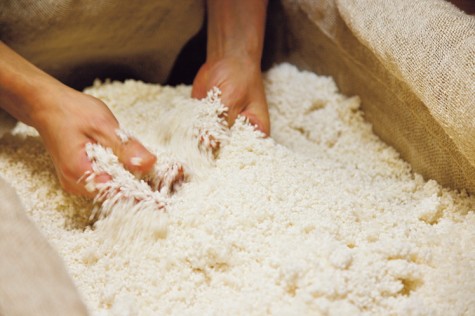
Adding mold spores to steamed rice to make koji. Confirming the state of the koji requires a general mobilization of the senses: sight, touch and smell.
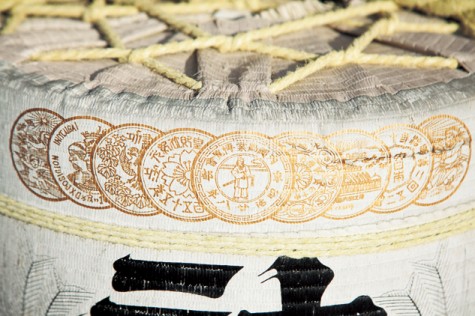
Komodaru barrels are a familiar sight at Japanese opening ceremonies. The straw wrapping was originally added to protect the barrels during transportation.
My official job title is Plant Manager, but in practice I also do the work of a master brewer. How long it takes for a new employee to become a master brewer varies between individuals. Some can do it in five years, other may need more than ten. It is only when others recognize you as a master brewer that you have become one. I still have a long way to go and wouldn’t presume to call myself a master.
Small batches are still done by hand, just like the masters did in the past. Even machine-made sake is really man-made, I’ve come to realize. It just boils down to a question of quantity. Sake-brewing starts by soaking rice in water, and already from that stage you have to be extremely careful. You can’t take your eyes off it for a second. You have look after it all the time. That will probably never change, no matter how far the technology advances.
Aside from the brewing craft, I learned many other things from the old master. In order to make good sake, you have to work closely as a group for half a year, so it is important to keep on good terms with each other. Bad-mouthing each other is absolutely not allowed, he told me.
Both the master and the rest of the staff were very deft with their hands. They made their own tools. For example, the heads thought up and constructed the basket used for transferring steamed rice to the tank, without any drawings. In fact, all heads I know are very handy and can easily fix complicated problems with the plumbing. These old-school people have adapted beautifully to machines as well. Whether they use machines or old-fashioned tools, they know how to make good koji, and at what temperature to stop the batch. I still have a lot to catch up with there. They also know the microbiology and chemistry necessary for sake-brewing by instinct. We have to absorb what we learned in school, and keep studying based on our own experience.
Honing the intuition by making mistakes
If you lack experience, your intuition won’t work. It is only by accumulating failures and trying some fairly far out things that you will learn how far you can go. When you observe the senior staff you may think of a cleverer way of doing a certain procedure. It is when you try it for yourself and fail that you understand why the seniors were doing it the way they did. Sometimes you might come up with an actual improvement, of course. You have to find out by trial and error. There may be people with superb intuitions who get everything right from the beginning, but such people are extremely rare.
When making koji, it is not only the temperature, you also have to feel the hardness by hand. Whether the rice is steamed all the way through, whether there still is a hard core, whether the rice is cracked or whether it’s sticky. Sticky rice in particular is disqualified when making koji. If it is sticky, that means the grains are moist on the surface and the mold hyphae are wrapped around the grains. This is something you have to feel. The condition of the rice cannot be analyzed. You have to be able to tell whether it’s good or bad the moment you touch it with your hands.
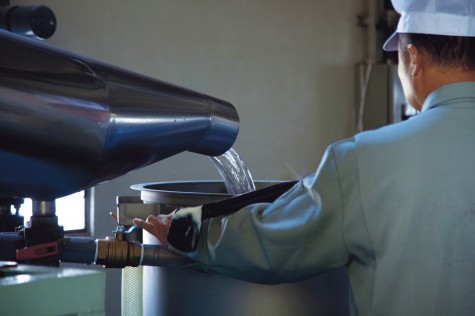
The quality of the water used for washing the rice and for brewing has a huge impact on the flavor of the finished sake.
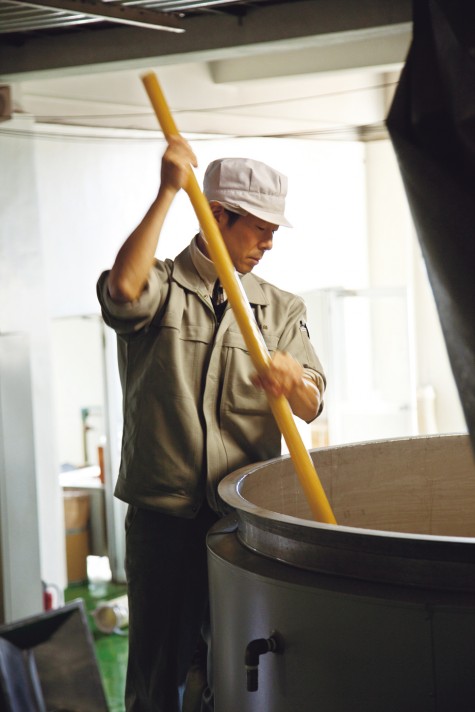
The mash is stirred with a wooden stick to help fermentation.
When making a large batch, the steamed rice pours out continuously from the machine, and the feel is different at the beginning and at the end. The question is at what point to decide. Mechanization may be progressing, but this is still difficult for large batches.
We soak the rice so that the middle 80% will become good steamed rice while the uppermost and lowermost 10% are discarded. It’s like a game where our mission is to adjust the given environment into conditions suitable for making good sake, and then watch carefully over it, regardless of the size of the lot.
In order to hone your senses and make use of them, it is important to take care of your health. It absolutely won’t do to catch a cold. If you are in charge of sake-brewing, you can forget about taking time off for the new year holidays, and when making koji, or small batches, you practically have to work around the clock.
There are also an old rule to avoid eating fermented foods like natto. It may not affect larger batches, but we are always making smaller batches too in parallel, so you have to be careful about such things as well.





